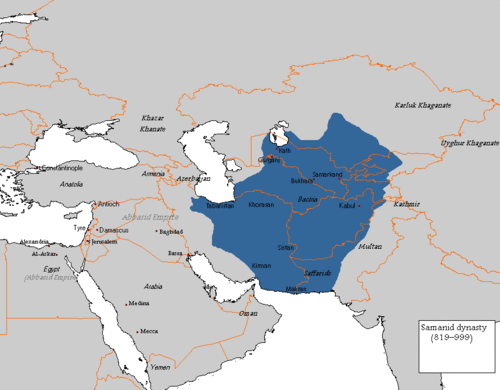| Regions with significant populations | |
|---|---|
| Languages | |
| Religion | |
| Islam |
Tajiks in Pakistan are residents ofPakistan who are ofTajik ancestry. The Tajiks are aPersian-speakingIranian ethnic group native toCentral Asia, living primarily inAfghanistan,Tajikistan, andUzbekistan.
There are also Afghan Tajiks refugees inPakistan. According to theMinistry of States and Frontier Regions in 2005, at least 7.3% of allAfghans living in Pakistan or roughly 221,000 individuals were categorised as ethnic Tajiks.[1][2] There are also expatriates from Tajikistan.[3]

During the ninth and tenth centuries, the western portions of Pakistan were part of theSamanid Empire, which was an Iranian dynasty of Tajik roots.[4] It is also referred to as the "first Tajik state".[4] TheGhurid dynasty was another presumably Tajik dynasty that controlled parts of Pakistan in the early 13th century.[5][6]
Pakistan andTajikistan are now separated by a narrow strip of Afghan territory known as theWakhan Corridor.[7]
TheGojal,Ishkoman andYasin valleys of northern Pakistan'sGilgit-Baltistan region, as well asChitral district, are home to a significant native population ofPamiri Tajiks, known as theWakhis.[8][9][10][11] They speak theWakhi language, which is anEastern Iranian language distantly related toPersian.[11] TheWakhi Tajik Cultural Association represents and promotes Wakhi culture in Pakistan.[12][13]
There were 221,725Afghan Tajiks living in Pakistan in 2005, according to a census by the Ministry of States and Frontier Regions.[1][2][14] They were amongst the massive influx ofAfghan immigrants to Pakistan following theSoviet–Afghan War outbreak in 1979, while others arrived during the Afghan civil wars starting in1992 and1996 to escape theTaliban regime, or more recently, the post-2001war in Afghanistan.[15][1] Tajiks comprised 7.3% of the Afghan population in Pakistan, making them the second largest ethnicity afterPashtuns who formed 81.5% of immigrants.[1] The census showed that they were divided into 42,480 families. In terms ofsex ratio, 112,819 individuals (50.9%) were male and 108,906 (49.1%) were female.[1]
Obtaining updated figures remains elusive as many Tajiks returned to Afghanistan or migrated abroad in the past several years,[16][15] while some end up overstaying their visas or don't have valid documentation of their stay and travel when probed by law enforcement agencies.[17][18][19]
InBalochistan, around 43,000 Afghan nationals living in the province as of 2005 were identified as Tajiks.[20] Tajiks inQuetta worked mainly in clerical jobs and as teachers. They were wealthier in socioeconomic status compared to their Afghan counterparts of other ethnicities.[20]
A small number of Tajiks also live in theIslamabad-Rawalpindi metropolitan region,[21] and inKarachi inSindh,[22] where their population was up to 20,000 in 2004.[16] Assimilating into Karachi's social and economic city life tends to be more challenging for Tajiks and other smaller communities than it is for Afghan Pashtuns, who are comparatively well-integrated.[22]
During the 1990s, as a result of theTajikistani Civil War, between 700 and 1,200 Tajikistanis arrived in Pakistan, mainly as students, the children of Tajikistani refugees in Afghanistan. In 2002, around 300 requested to return home and were repatriated back to Tajikistan with the help of theIOM,UNHCR and the two countries' authorities.[3] As of 2009, there were around 140 Tajikistani students pursuing education at Pakistani universities.[23]
Tajikistan has an embassy in Islamabad,[24] and honorary consulates in Karachi,[25]Lahore and Peshawar.[26] Airlines such asTajik Air andSomon Air have expressed commercial interest in, and previously operated, flights linkingDushanbe to Pakistan in order to facilitate the movement of tourists and businesspeople between both countries.[27][28][26][29] National festivities such as theAfghan Independence Day andTajik Independence Day are observed by the Tajik diaspora.[30]
The census found 3,049,268 Afghans living in Pakistan, 42% of them in camps and 58% in urban areas. Over 81% of the Afghans were Pashtuns, with much smaller percentages of Tajiks, Uzbeks, Turkmen, and other ethnic groups (see Figure 1).
For more than 100 years the Samanids ruled most of Central Asia and parts of present-day Afghanistan, Iran, Pakistan and India. The Samanid Empire is regarded as the first Tajik state...
The Chitral and Kalash valleys of the Hindu Kush Mountains are located north of the Swat Valley in the Chitral district of the North-West Frontier Province and are bordered by Afghanistan on the north, south, and west. The Wakhan Corridor separates Chitral from Tajikistan.
Tajik diaspora occurs in Afghanistan (9,450,000), Tajikistan (6,787,000), Uzbekistan (1,420,000), Pakistan (220,000), China (34,000), Russia (201,000), United States (52,000), Kyrgyzstan (47,500), Canada (15,870), and Ukraine (4,255).
I do want to go back, but God knows when," said Mohammed Islam, a Tajik from the northern Afghan province of Baghlan who left his country 20 years ago. "If the government helps us with housing or setting up a business, I will go.
Most of these Afghan refugees were of Pashtun stock but Karachi also became home to smaller contingents of Uzbeks (30,000 to 40,000 according to some estimates) and Hazaras and Tajiks (20,000 each).
Afghan migration into Karachi also features other groups, including Persian-speaking communities such as Tajiks... Migrants from Afghanistan are relatively underprivileged, and among Afghans some (such as the Tajiks) are clearly more insecure and vulnerable than others.
Around 142 Tajik students are studying at the universities of Pakistan in 2009...
In Uzbekistan, there are 15 million Tajik people split between [the cities of] Tashkent, Samarkand and Bukhara. Those are clear destinations that we are looking at and have negotiated rights for. We've got Afghanistan, which has more than ten million Tajiks… There's Pakistan as well – Islamabad or Karachi...
Bandishoyev says that both Tajik tourists and businesspeople are interested in the establishment of an air route to Lahore.
Coming from an ethnic Persian-speaking Tajik tribe, the Afghan family had left its ancestral town of Jalalabad some 150 years ago and settled partly in Bombay (now Mumbai) and partly in a tiny coastal town of Karachi.